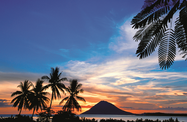Negotiations to buy a large share of a regional airline with Sarawak could boost Sabah’s domestic tourism sector by bringing in increasing numbers of tourists.
The state is looking to counter the negative effects of Malaysia Airlines’ (MAS) decision in February to cancel direct flights from Kota Kinabalu International Airport to Osaka, Perth, Haneda and Incheon in 2012. With a view to redressing the gap in air connectivity, Sabah, along with neighbouring Sarawak, plans to buy MASwings, a MAS subsidiary.
Sabah’s tourism, culture and environment minister, Masidi Manjun, told local media in early July that the state was negotiating with Sarawak and “the relevant parties” to look into the possibility of buying a substantial number of shares in MASwings.
"This has been announced by the Prime Minister and we are looking at majority equity or combination of shares between Sabah and Sarawak," he said, adding that the airline is currently reviewing financial data to determine its purchase price.
If the purchase is successful, Sabah could be much better connected to the region.
“Once the takeover of MASwings is completed, Kuching and Kota Kinabalu airports will be transformed into regional transit centres with direct connectivity to East Asian countries, such as South Korea, Japan, China, Hong Kong and India,” said Amar Abang Johari Openg, the minister of tourism for Sarawak.
However, aviation industry sources told The Sun newspaper in June that the task of turning MASwings – a community service airline – into a regional one would be a “daunting and expensive task” for which both state governments were unprepared.
Nonetheless, the possibility of attracting more tourists to the state via a dedicated airline would be great, particularly given a 33% increase in Australian arrivals in 2011, according to Manjun.
“[MAS’s cutting of flights from Sabah] will especially affect the Japanese and Western Australia markets,” he said in June.
Another key area of growth identified for the sector’s expansion is attracting more tourists from China, which is geographically close to Sabah and with which the state shares deep historic, cultural and ethnic links. Visitors from China rose by 37.6% in 2011, and local officials said in June that a number of Chinese firms have expressed interest in investing in the tourism industry.
While tourist visits to the state rose 13.6% from 2010 to 2.84m in 2011, contributing RM4.98bn ($1.56bn) to the economy, officials have said the sector has the potential to do more for Sabah’s economic growth.
As well as possessing white sandy beaches, lush jungles and exotic wildlife, the state is home to attractions such as Mount Kinabalu and scuba and snorkelling destinations, particularly on Sipadan Island.
To capitalise on these assets, in June, Musa Aman, the state’s chief minister, announced that the first phase of a 25.3-km pedestrian walkway project in Kota Kinabalu – an extension of plans to develop the city into a modern “gateway” for the state’s natural attractions – would begin in 2012.
The RM38m ($11.92m) walkway plan is one of three tourism projects planned for the city under the Sabah Development Corridor (SDC) programme. The other two initiatives are an RM12m ($3.76m) restoration of the historic Atkinson Clock Tower and an RM45m ($14.11m) park project at Sembulan River.
In June, Ng Yen Yen, Malaysia’s minister of tourism, pledged to draw up a new strategy to promote the 607-ha Sabah Agriculture Park and identified homestays as an emerging way for tourists to experience local culture and traditions.
Based on a three-year survey by Sabah’s Ministry of Tourism, Culture and Environment, the homestay programme has attracted 59,820 tourists and generated an income of RM7.04m ($2.21m) since 2009. Yen added that the programme is the part of the STM’s strategy to open opportunities for participation from rural communities.
A month earlier, James Dawos, the deputy minister of tourism, identified “bio-tourism” as a trend the state should explore. Dawos said tourists visiting Sabah will want to witness the state’s biodiversity in comfortable, well-managed surroundings, rather than travel large distances to remote sites promoted as eco-tourism destinations.
Another niche market that has been identified is archaeo-tourism, or tours that focus on Sabah’s history. The director of the Global Archaeology Research Centre at Universiti Sains Malaysia, Mokhtar Saidin, in April proposed tours to some of the sites of some of the university's key finds, such as artefacts and human teeth that are estimated to be around 16,000 years old found in Balembangan Cave on Banggi in Kudat.
The potential influx of Australian and Chinese tourists, as well as increasing investment, has great economic potential, though the sector will need to take care to maintain the state-wide commitment to green development that has given Sabah an edge in the global tourism market.

